Many people believe that ammonia is an exclusively therapeutic substance that is used in medicine to remove a person from an unconscious state and as a therapy for various diseases. And what is the connection between salmon and strawberries? But those who grow a garden, cultivates a vegetable garden, it is known that in addition to the standard application ammonia is an indispensable assistant on the site.
Table of contents
The composition and properties of ammonia, can I use
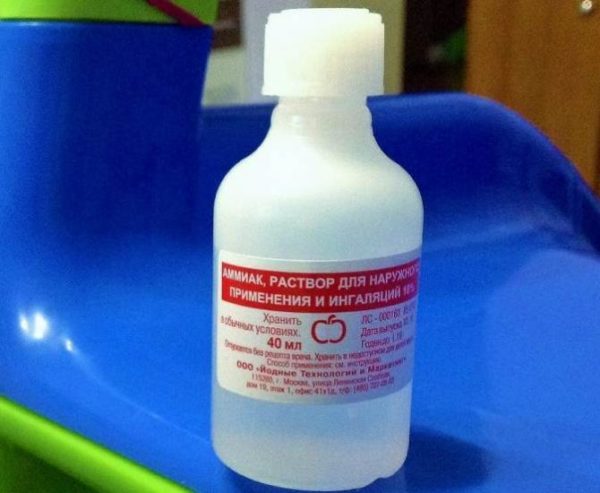
Ammonia is a colorless gas that has a sharp and very pungent odor; in combination with water, it forms ammonia. On sale you can find 10 percent and 25 percent concentration of this substance. Experienced gardeners use ammonia for the following purposes:
- As a liquid nitrogen fertilizer suitable for both seedlings and adult plants. In terms of quality, this fertilizer can be compared with such generally accepted fertilizer as wood ash;
- Ammonia solution is effective in preventing the appearance of many insects and pests.
Using it, you can grow organic crop and will not hurt my head about nitrates. The use of chemicals in this case will be reduced to a minimum.
The benefits and harm of ammonia, why water
Ammonia solution is actively used in gardening. It is a source of nitrogen.which is very important for the full development of many plants. With this feed you can improve the overall condition of the plants, any crop becomes fruitful and the quality of the fruits - super!
Regular fertilizing and spraying plants with nitrogen fertilizers leads to the following positive results:
- active growth of green mass;
- plants form a large number of flowers;
- after correct feeding with liquid ammonia, application of other mineral fertilizers is not necessary;
If you pour it with this remedy, effective prevention of many pests will be performed, namely:
- aphid;
- onion fly;
- carrot fly;
- Medvedka;
- wireworm;
- covertly;
- room flies;
- ants, etc.
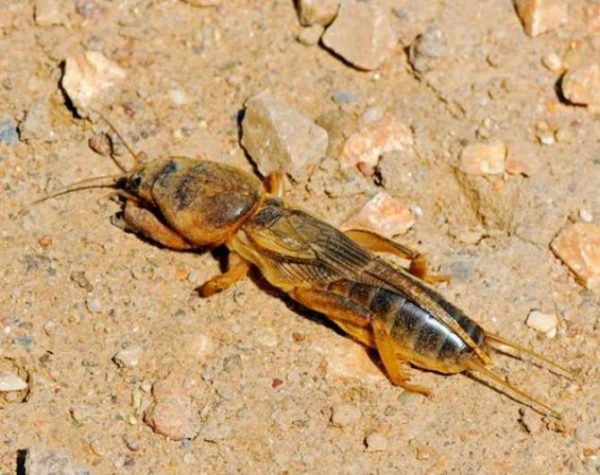
Medvedka - one of the worst garden pests
But if the product is used during fruiting, the resulting crop must be thoroughly rinsed, because the active substances can settle on the surface of the fruit.
Security measures when spraying and feeding the garden
Using ammonia in gardening, it is worth remembering that he is still is poisonous and very important to follow certain precautions.:
- When working with a substance, the use of personal protective equipment (gloves, respirator or mask) is mandatory. This is due to the fact that vapors of ammonia trapped on the skin or mucous membranes can cause a chemical burn;
- You can not add to the solution of any substance, with the exception of iodine and laundry soap;
- If just prepared solution got on unprotected skin areas, immediately you need to drain them with soapy water. Then you need to seek help from a specialist.
Poisoning with ammonia can cause serious consequences, so you need to work very carefully with such a substance. Ammonia vapors evaporate quickly enough, so precautions will be relevant at the time of its direct use.
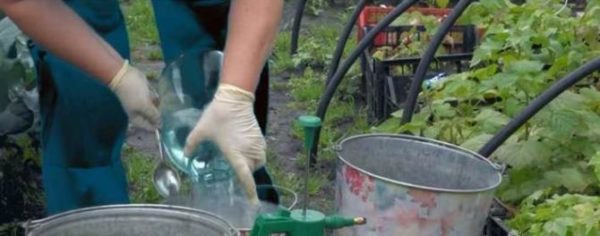
In addition to basic precautions, there are several contraindications that should be considered when working with a substance. It is not recommended to use for pregnant and lactating women, people suffering from epilepsy.
Application for processing various plants and seedlings
Preparing ammonia solution is quite simple, but it should be borne in mind that the dosage, proportion and method of use for different garden crops will differ from each other.
In order to prevent too rapid volatilization of ammonia, it is mixed with 72% of household soap. With its help, a thin film is created on the leaves of plants, which is a reliable protection against diseases and pests, but at the same time, it also allows air and moisture to pass through.
To prepare such a tool, a piece of soap is rubbed on a fine grater and diluted in 1 liter of hot water.The finished soap solution is poured into a bucket of water, ammonia is added and mixed thoroughly.
Do not allow the product to fall onto the leaves, in which case a chemical burn may occur. Processing with this substance is carried out in the early morning or late evening in dry and calm weather.
Liquid ammonia for strawberry - fertilizer
Processing strawberries with ammonia is necessary in order to increase the yield and help the plant build up its green mass. Also, this tool is actively fighting pests and is a prophylactic agent of their appearance.
Three treatments are performed to achieve the best effect.. The first of them, in the spring, aims to get rid of pests and fungal infections, wintered in the soil. Also, with the help of spring treatment, the amount of nitrogen necessary for the plant is introduced. Processing is carried out by watering strawberry bushes with a solution consisting of:
- 40 milliliters of 10% ammonia;
- 10 liters of water;
- 1 liter of soap solution.
The time for doing such work falls to the end of March and the beginning of April. If any noticeable amount of fertilizer gets on the above-ground part of the plant, after finishing the treatment, the bushes are additionally watered with clean water.In order to get rid of the remaining pests after flowering strawberries are watered with a solution that must be diluted more:
- 3 tablespoons of ammonia;
- 10 liters of water.
The last feeding is carried out after picking berries. The main purpose of this procedure is to restore the plant after fruiting and contribute to the formation of the future harvest. A suitable mixture is prepared from:
- 40 milliliters of 10% ammonia;
- 10 liters of water;
- 5 drops of iodine.

Strawberry fertilizer with ammonia
If you use the tool when growing strawberries, the quality of the crop will improve and the risk of insects will be reduced to a minimum.
Use solution for onions and garlic - proportions
If you wish to grow onions and garlic with a juicy green feather, it is necessary to carry out regular plant nutrition with nitrogen fertilizers.Also, this procedure will be necessary if the plant shows signs of nitrogen starvation, such as yellowed and twisted foliage.
For fertilizing garlic with ammonia solution, the following rules are followed:
- If the plant shows strong signs of nitrogen deficiency, it is poured over with a solution prepared from a tablespoon of 25% ammonia and a liter of water;
- As a preventive measure, in the beginning of summer, two treatments are carried out with an agent prepared from 30 milliliters of 10% ammonia and a liter of water.
Feeding onions will depend on the objectives of growing the crop:
- For receiving dense and juicy greens, in June, the plants are fed with a solutionconsisting of a teaspoon of ammonia and a liter of water;
- In order to increase the mass and quality of root crops, the beds are watered with an agent consisting of a tablespoon of ammonia and a bucket of water.
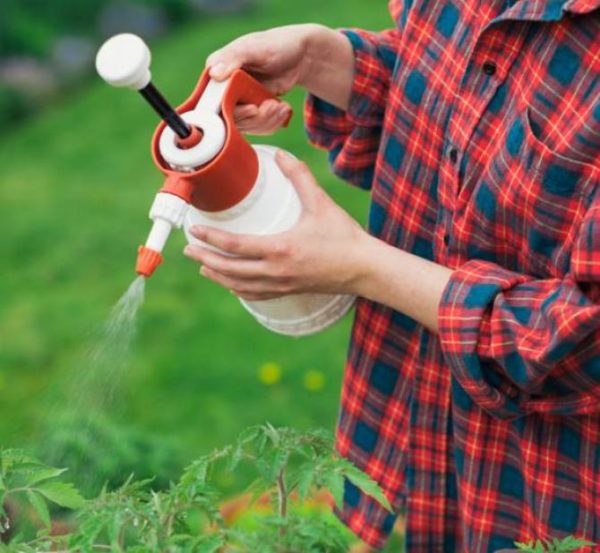
Protecting the crop, spraying liquid ammonia
In order to get rid of insects, the following amount of the substance is diluted in a bucket of water:
- onion and carrot fly - 5 milliliters;
- wirewound - 10 milliliters;
- covertly - 25 milliliters;
- Aphid - 50 ml of ammonia should be used in combination with 50 grams of soap.
Ammonia is a universal remedy, with which you can feed the plant and at the same time protect it from pests.
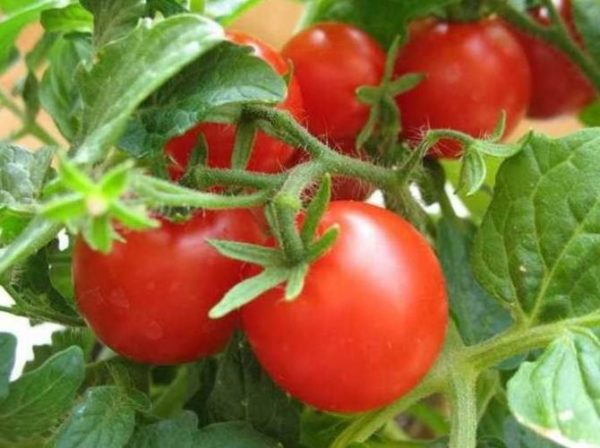
Plank for cucumbers and tomatoes - process in spring
In order to help cucumbers actively build up the green mass and form the ovaries, it is necessary to regularly apply nitrogen-containing top-dressings:
- After the shoot size reaches 10-15 centimeters in length, it is watered once a week with a 1% solution of ammonia;
- At the time of formation of the ovaries, the concentration of the substance is doubled;
- If the leaves of the plant begin to wither, dry and appear yellowing, a one-time feeding is recommended with a 4% solution.
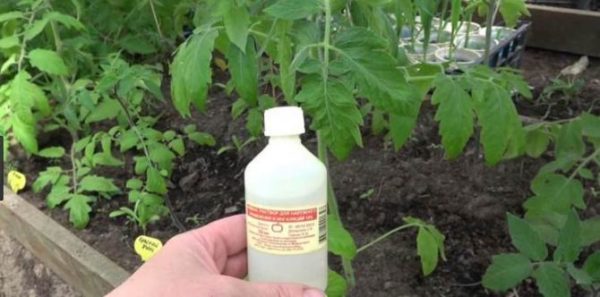
In order for tomatoes to form powerful bushes and large fruits they are treated similarly to cucumbers. The result of fertilizing with liquid “Tatyana” tomato varieties is indicative - the yield is 20% higher compared to plants that have not received such additional feeding.
Ammonia for bell peppers and cabbage - a pledge of the harvest
Bell peppers and cabbage, as well as other crops. love nitrogenous fertilizersI. With their help, a powerful bush is formed and flowering is improved. Ammonia helps plants to cope with their main tasks and provides decent protection against many pests. Use it as well as when growing cucumbers or tomatoes.
Ammonia is a very valuable find for many gardeners.. This universal remedy allows you to fertilize not only the above cultures, but also potatoes, beet, zucchini, eggplant and other cultures. With this tool you can thoroughly enrich the plants with nitrogen and effectively protect against insects. In addition, ammonia can be purchased at any pharmacy, and the cost of this substance will be affordable for everyone.
